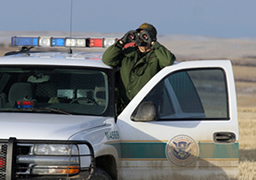 Learn more about the programs and initiatives that compose the Department's multi-layered defense strategy for securing U.S. borders and ports.
Learn more about the programs and initiatives that compose the Department's multi-layered defense strategy for securing U.S. borders and ports.
The Department of Homeland Security is responsible for:
- Managing the nation's borders and ports-of-entry
- Preventing the passage of individuals or goods from entering the United States unlawfully
- Working overseas to strengthen U.S. defenses against illegal smuggling and immigration
The multi-layered defense strategy includes the following programs and initiatives:
- C-TPAT (Customs Trade Partnership Against Terrorism): CBP created a public-private and international partnership with nearly 5,800 businesses to improve baseline security standards for supply chain and container security. For more on C-TPAT, visit CBP.gov.
- Screening and Inspection: U.S. Customs and Border Protection (CBP) screens 100% of all cargo before it arrives in the U.S. using intelligence and cutting edge technologies. CBP inspects all high-risk cargo.
- CSI (Container Security Initiative): Enables CBP, in working with host government Customs Services, to examine high-risk maritime containerized cargo at foreign seaports, before they are loaded on board vessels destined for the United States. For more on CSI, visit CBP.gov.
- 24-Hour Rule: Under this requirement, manifest information must be provided to CBP 24 hours prior to the sea container being loaded onto the vessel in the foreign port.
- Use of Cutting-Edge Technology: CBP is currently utilizing large-scale X-ray and gamma ray machines and radiation detection devices to screen cargo. CBP also uses biometrics to help verify the identities of most non-U.S. citizens arriving at U.S. ports of entry, as well as to identify non-U.S. citizens they encounter attempting to enter the country illegally. Learn more about how biometrics are helping to secure U.S. borders and ports.
